It didn't seem appropriate to add this as a comment on any of the other discussions, so I thought I might start a discussion pertaining to new releases related to the play. I found this link on one of the other forums and wanted to share it here in case anyone missed it. It reallys seems our excitement is warranted.
If anyone else sees a new press release, you are invited to post it here.
Investors Anticipate What Could Be the Largest Shale Play in American History
LUBBOCK, Texas, Nov. 27, 2012 /PRNewswire/ -- Expectations are building for America to become the world leader in oil production by 2017 due in part from what some are supposing could be the largest oil play in American history, taking place on Texan soil.
In the heart of Texas's Permian Basin, lies the Cline Shale, an oil shale field running 140 miles long and 70 miles wide. Devon Energy and Chesapeake Energy, two oil companies, are reporting impressive figures based on the short amount of time they have had to explore. Devon Energy's test wells show the Shale contains 3.6 million barrels of recoverable oil per square mile. With an approximate 9,800 square miles of Cline Shale, this would amount to over 30 billion barrels of recoverable oil, exceeding both the Bakken fields in North Dakota, and the Eagle Ford in Texas by nearly 50 percent.
Taking into account the projected 200 to 550 depth of the Shale, this would be equivalent to having ten Eagle Ford Shales stacked on top of each other. The oil to dry gas ratio of the Shale is also garnering attention, with the Shale containing 85 percent oil and liquid rich gas. When you combine that with the low operating costs it takes to produce the oil in the Basin, about 50 percent less than the Bakken, it is shaping up to be one of the greatest oil & gas booms America has ever seen.
There are two primary deficiencies that the Cline Shale region will need to overcome to be able to make history: lack of housing due to exponential population growth to small town infrastructures, and lack of global distribution for the large amounts of liquid gas being produced. If the deficiencies are adequately addressed, the boom stands a better chance of maintaining momentum.
LubbockInvest, a real estate investing firm, is addressing the housing lack through Stone Bridge Estates, a 50 acre 265 lot manufactured home development in the heart of the Permian Basin, aimed at providing high-end, affordable housing for the employees brought to the area due to the boom. This type of housing is in high demand since many of the individuals brought to the area lack creditworthiness, preventing them from obtaining traditional housing. According to Midland City Manager, Courtney Sharp, "Oil and gas company leaders also say that cumulatively, they still could use as many as 10,000 more employees in the coming years." As it stands, housing will continue to be a deficit that could hinder the boom, but is being addressed at a satisfactory pace.
Teekay LNG Partners, a Liquid Natural Gas Carrier, is addressing the deficiency that such large liquid gas depositories will cause. Although gas is extremely inexpensive in the United States, it remains pricey in nearly every other country in the world. Teekay has been ramping up its ability to export liquid natural gas around the world by adding six additional vessels to its inventory in October of 2011. With the presence of an international market, the profit produced from the Cline Shale will increase quite dramatically as most of the gas extracted is already liquid-rich gas.
Although it is too early to call this the largest play in American history, it is clear that intentional companies are anticipating that this is precisely what it could be.
Contact:
Julie Templeton
(806) 787-3876
SOURCE LubbockInvest



